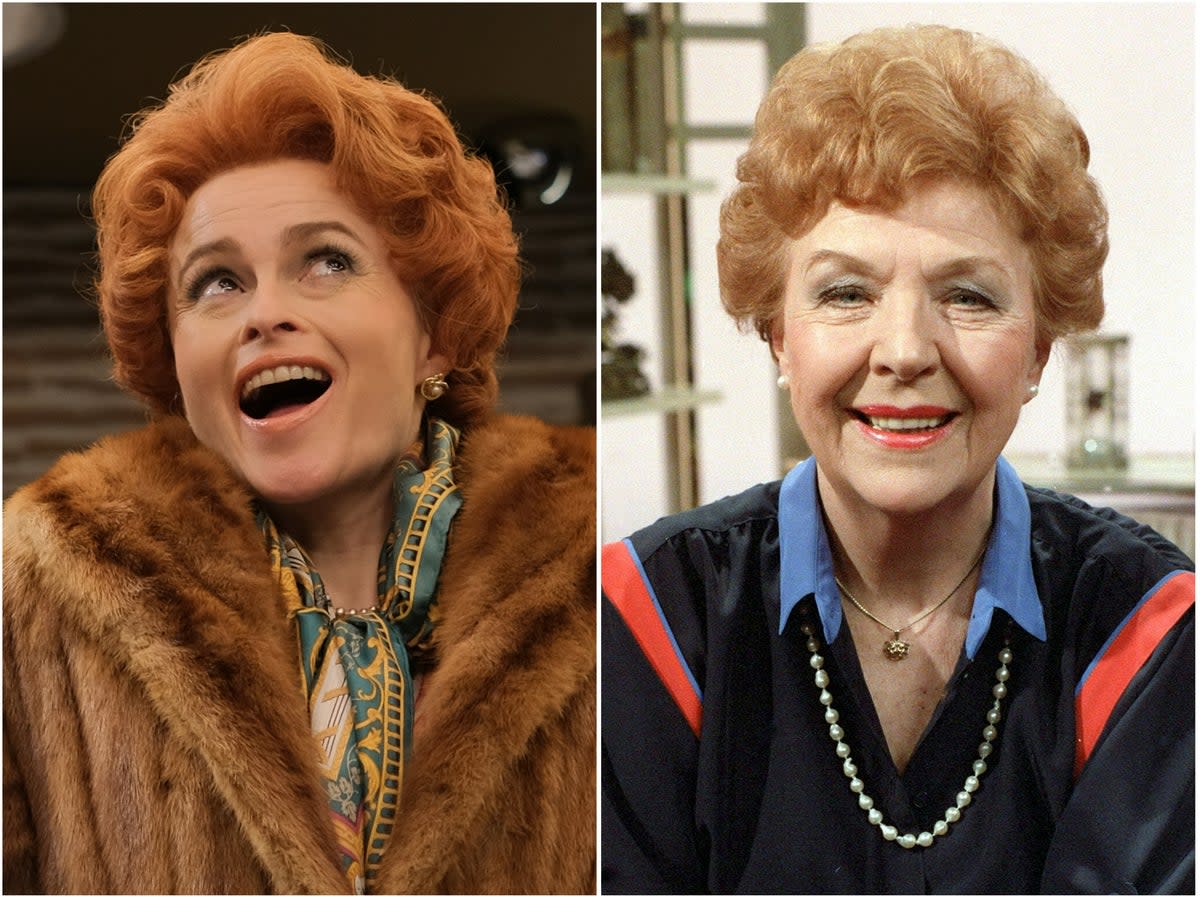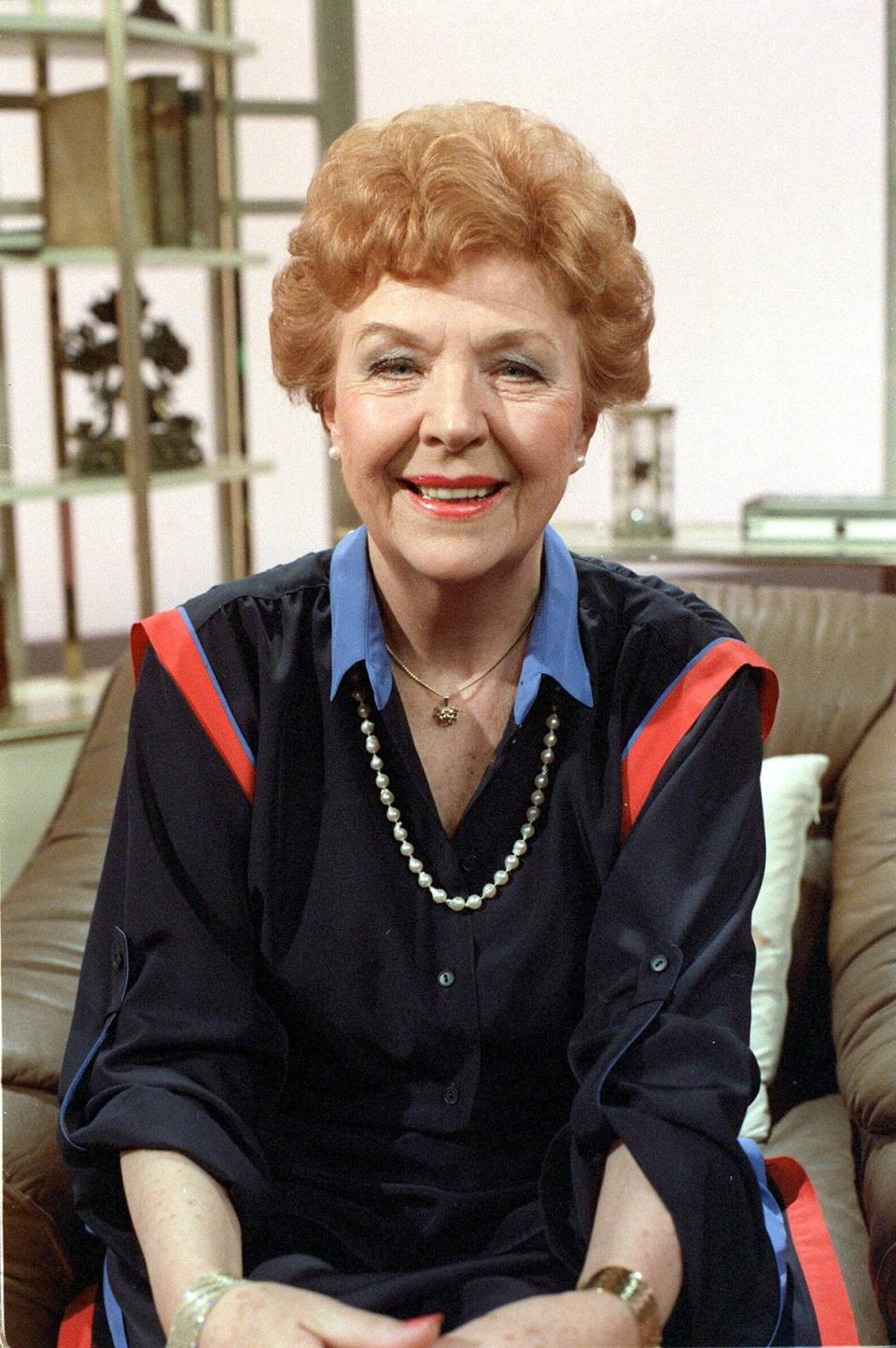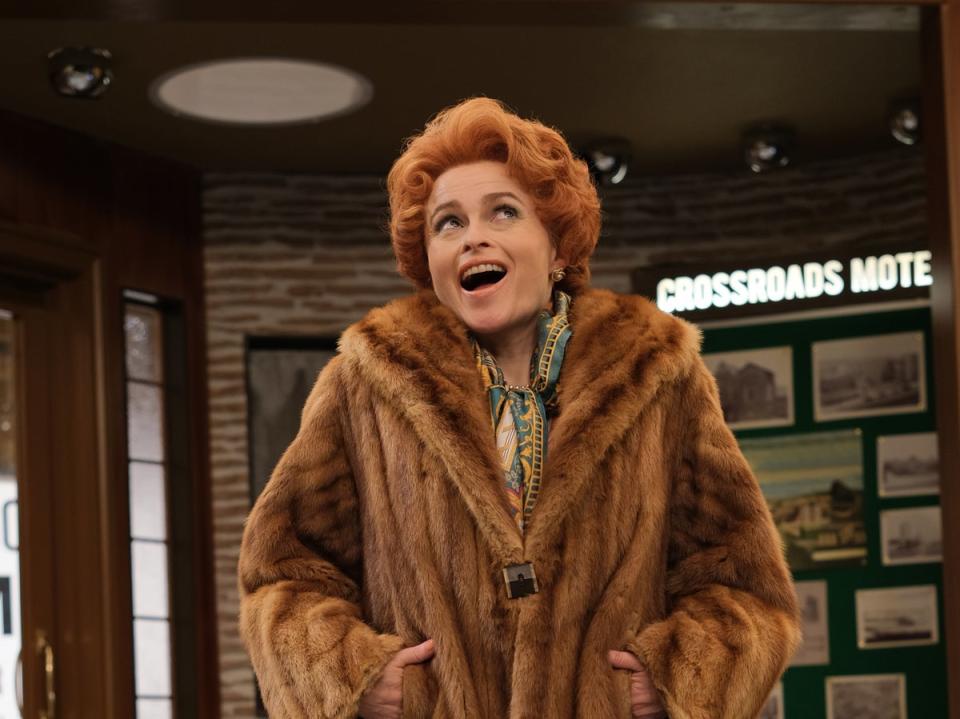Welcome to Nollywood: The staggering true story of Crossroads queen Noele Gordon

As the credits rolled on another episode of Crossroads on 4 November 1981, the switchboards at ITV started to jam. After watching the show’s beloved Midlands motel go up in flames, hundreds of viewers picked up the phone in tears to ask one question: would Meg Mortimer, the onscreen alter ego of actress Noele “Nolly” Gordon, make it out of the blaze alive? The odds for Meg, last seen clutching some sleeping pills, didn’t look good. The Sun claimed in a front-page splash the next day that some fans had even phoned up hospitals to ask about the injuries she might have sustained in the fire.
It was the culmination of nearly five months of outrage and hysteria that had begun in June, when news first broke that Gordon’s much-loved character would be written out of the soap. This was not a mutually agreed parting of ways – it was against Gordon’s own wishes. Told by TV executives that “all good things must come to an end”, she had been shown the door after 17 years as Crossroads’ matriarch. More than four decades later, the story of Gordon and her unceremonious sacking has been brought to life by Russell T Davies in ITVX’s three-part series Nolly, with Helena Bonham Carter playing the soap queen.
And what a story it is. Before she made her debut on the famously rickety sets of Crossroads in 1964, Gordon’s showbiz career took her from the West End stage to her own chat show. An eight-time TV Times Award winner, she deserves to be mentioned in the same breath as soap icons like June Brown, Barbara Windsor and Julie Goodyear, but in the years since her death, her staggering career has been overlooked.
Born on Christmas Day in 1919 and given a festive middle name, Joan Noele Gordon made her stage debut as a toddler at the East Ham Palace in London. Nineteen years later, when she was part of a repertory company at a theatre in Penge, a young man turned up, looking for a girl with “definite colouring”. He worked for John Logie Baird, the Scottish inventor and television pioneer, who needed someone to act as a model for experiments in colour transmission.
Chosen for her “blue eyes, fair skin and very dark hair”, which she would later dye red, Gordon would be driven in a Rolls-Royce to nearby Crystal Palace after finishing her evening performance. At Baird’s studio, she was dressed up in a series of vibrant hats, once with her face “painted with broad green vertical stripes”, as he and his colleagues trialled new technologies. She eventually became the first woman ever to appear on colour television. “Baird was enchanting, always kind and gentle, and he always gave me the full star treatment,” she later told TV Times. “He seemed rather vague. But he wasn’t really vague at all.”
Another big break came when she landed a part in the original West End production of Brigadoon in 1949, playing fiery milkmaid Meg Brockie, but television would remain her defining medium. On the advice of both her agent, Lew Grade, and Valentine “Val” Purnell, the married impresario and TV exec with whom she had a 20-year affair, she spent a year studying television production at NYU. While in New York, Gordon spent hours making notes about US programming, paying attention to the Americans’ fondness for daily soaps. Upon her return in 1955, she joined Associated Television, part of the ITV network, to present its first ever programme, The Weekend Show. At the same time, she served as the broadcaster’s head of lifestyle, making her ITV’s first female executive.
Gordon’s next challenge was launching ATV’s Midlands network the following year. To fill schedule space at short notice, she was handed her own chat show, Tea with Noele Gordon. It became so popular that she sidelined her producing career to focus fully on presenting – not bad for what had been intended as emergency filler. Series like Lunchbox, a This Morning-style magazine show, and Noele Gordon Takes the Air followed, the latter documenting her attempts to learn to fly. It seems she managed to make light work of that, too. “She is adaptable and easy to teach,” her instructor Arthur Penzer remarked in a promotional piece for TV Times. “On her first flight, she taxied the aircraft on and off the runway.”
Also on Gordon’s to-do list in the name of daytime television? Training as a firefighter, driving a steam train, going down a mine... as well as becoming the first woman to interview a prime minister on TV, when she sat down with Harold Macmillan in 1958. Then there was her angling show, A New Angle on Noele Gordon (a title that Alan Partridge would surely be proud of).
It was her role as Meg Mortimer in Crossroads, though, that would cement her status as “the Queen of the Midlands”. Launched in 1964, the ATV soap was built around Gordon’s character, who used her late husband’s life insurance to turn her house and the surrounding land into a sprawling motel. Filmed at speed on a notoriously low budget, sets would visibly wobble and the continuity was patchy. One character, Glenda Brownlow, went off to the bathroom and wasn’t seen for seven months.

Meg had more than her fair share of bizarre storylines: one husband tried to poison her to take her money, and she even ended up behind bars for knocking the postman off his bike (she’d swerved to avoid hitting a cat). Viewers thought she’d finally found happiness when she married Hugh Mortimer (John Bentley), and the couple had their union blessed in scenes filmed at Birmingham Cathedral; fans could buy a special spin-off album, featuring a duet between Gordon and Bentley (like a proto-Kylie and Jason) as well as music from the ceremony, to celebrate the nuptials. Then, in a cruel twist, Hugh was kidnapped by Australian terrorists, and died of a heart attack.
As Bonham Carter’s character puts it in Nolly, the soap could be “bloody nuts” – but it was also seriously popular, watched by 15 million at its peak. Yet despite pulling in impressive numbers, Crossroads was an embarrassment for ATV bosses. When Charles Denton was appointed head of programming, he decided to focus on more upmarket, prestigious dramas (much like the one that Gordon has now inspired – an irony she’d probably enjoy). Crossroads would have to go – but instead of axeing it outright, he and his fellow execs opted to get rid of Meg/Gordon, hoping audiences would abandon the series in protest. Plus, Nolly’s TV nous meant that she liked to comment on the production – and to get her own way. She could, as we see in Davies’s show, be seen as “difficult”.
Gordon didn’t go quietly. First, she pleaded with Grade, by then the head of ATV, to save her job. Then she went to the press, telling reporters that she had been sacked in tones so emotionless it was like the executive in question “was reading a weather report”. The viewing public sprang to her defence, gathering outside ATV Birmingham with “Save our Meg” and “Meg is magic” placards. Denton was the focus of much of their ire. “I got excrement through the post,” he told The Independent in 1993. “I never believed that really happened until it landed on my doorstep.”

But how would Meg bow out – and, most importantly for worried fans, would she leave the soap alive? Media speculation was seriously intense. Producer Jack Barton, played by Con O’Neill in Nolly, told ATV News that he’d had to dodge “reporters crawling on their stomachs through cabbage fields, trying to get pictures” of Meg’s last act. To throw them off, five separate endings were recorded. Most were tragic: Nolly shows the actor who played Gordon’s onscreen daughter, Jane Rossington, played in Davies’s show by Antonia Bernath, attempting to emote during a funeral scene while helicopters hover overhead.
A week after the motel blaze aired, fans finally “breathed a sigh of relief when they discovered that Meg Mortimer had not perished”, as The Times put it. After receiving a mysterious phone call, Rossington’s character Jill was summoned to Southampton, where she boarded the QE2. Who should she find there but Meg, vividly eyeshadowed and very much alive? As high-camp soap plot twists go, it deserves a slot in the hall of fame. “I’ve turned my back on the hotel,” Meg sighs, before detailing her plans to leave the Midlands behind for good. When the boat sets sail, she waves regally from the deck, the queen of Crossroads to the last.
Though her high-profile firing certainly hit Gordon hard, she seemed to handle it in her own idiosyncratic style. In the depths of YouTube, there is grainy footage from the ATV Christmas party held shortly after her departure. Gordon arrives on stage dressed in black, complete with mourning veil, then proceeds to give an arch performance of the song “Say That We’re Sweethearts Again” (sample lyrics: “I never knew that our romance had ended/ Until you poisoned my food”).
Eventually she returned to her first love, the stage, appearing in shows such as Gypsy and Call Me Madam; later, she made a cameo in Crossroads when Jill and her new husband Adam Chance (Tony Adams) headed to Venice for their honeymoon. By 1985, producers were hatching plans for her to make a return to the soap – but Gordon, who had been diagnosed with stomach cancer, was too ill to do so, and died in April that year. Crossroads would bow out three years later.
Her gravestone hails a woman who “devoted her life to her career”. Gordon certainly blazed a trail for women, both behind and in front of the camera. “I don’t want to be equal to a man,” she said in one interview. “I think I am far superior – always have done.” Despite her achievements, though, she rarely gets her due as a soap legend and a broadcasting pioneer – perhaps Davies’s show will finally change that.
‘Nolly’ is streaming on ITVX from 2 February


